Marvel Rivals Best Team Compositions: Synergy & Meta Picks
Updated On: November 12, 2025 by Aaron Connolly
Top Marvel Rivals Best Team Compositions
These four team compositions really stand out in Marvel Rivals, mostly because of their strong Team-Up moves and smart hero combos. Each lineup leans into strengths like crowd control, burst damage, or just owning the battlefield.
Fantastic Four Dominance
The Fantastic Four Team-Up gives you one of the toughest defensive comps in Marvel Rivals. The synergy between Mr. Fantastic, Invisible Woman, Human Torch, and The Thing feels almost natural.
Mr. Fantastic tanks up front, taking the brunt of enemy attacks. Invisible Woman pops shields and healing, using her barriers to cover the whole squad.
The Thing jumps in with heavy crowd control. He can leap onto enemy flyers and slam them down, making eliminations way easier.
Human Torch flies around as the aerial flanker. He chases down enemy snipers and keeps them too busy to target your team.
If you want to push this comp even further, throw in Emma Frost and Magneto for more frontline control. Emma’s crowd control lines up perfectly with The Thing’s dives.
You’ll see this lineup shine on control point maps. All those defensive tools make it a nightmare for enemies to break through.
Projection Mirage Burst
Psylocke and Emma Frost anchor this high-damage comp. Their Projection Mirage Team-Up can wipe out targets in a flash.
Emma Frost sets things up with her crowd control. In diamond form, she shrugs off damage while she lines up the perfect engage.
Psylocke comes in hot with her mobility and assassin skills. She can delete priority targets and then vanish before anyone catches her.
Scarlet Witch piles on even more burst and area control. Her reality-warping skills throw enemy teams into chaos.
We usually run Magneto as the tank here. His barriers keep the squishier heroes alive while they pull off their combos.
A strong healer like Luna Snow rounds out the team. Her healing lets everyone survive those risky, aggressive plays.
This comp takes practice. You’ll need to nail the timing on your bursts to get those big eliminations.
Gamma Goes Boom
Hulk and his Gamma Charge bring raw power to the battlefield. This comp is all about explosive damage and locking down areas.
Hulk does double duty as tank and damage dealer. The longer a fight drags on, the stronger he gets—he’s just a monster in drawn-out brawls.
Iron Man supports from range with his repulsors. He can zip around and help Hulk from different angles, always keeping a safe distance.
Namor adds more area damage with his water attacks. His turrets keep up steady pressure on enemy positions.
We love adding Spider-Man for extra crowd control and mobility. His webs can set Hulk up for some devastating combos.
This group works best on small maps. Enemies have nowhere to run from Hulk’s rampage.
The team needs to give Hulk space and protect him while he charges up. If you can manage that, you’ll steamroll fights.
Symbiote Aggression
Venom leads this ultra-aggressive lineup that just overwhelms opponents. His symbiote powers make for wild team synergies.
Venom dives in as a tank, taking on multiple enemies at once. He brings both damage and crowd control with his symbiote tricks.
Peni Parker helps out with tech support from her SP//dr mech. Her traps and mines make zones that fit Venom’s playstyle perfectly.
Spider-Man jumps in as the second diver. His mobility keeps up with Venom, and he adds even more crowd control.
We always want a healer who can keep up with all this aggression. Mantis fits well, especially since she can boost damage too.
The last slot usually goes to a ranged damage dealer. That way, if the dive stalls out, you still have backup firepower.
This comp needs everyone to commit to the fight. If you hesitate, you’ll end up with scattered losses instead of clean team wipes.
Most Effective Meta Strategies
The 3-1-2 setup—three Vanguards, one Duelist, and two Strategists—pretty much rules the Marvel Rivals meta right now. Dive-heavy teams with extra damage can bulldoze through opponents, but cover-based strategies can also win big on some maps.
Balanced 2-2-2 Composition
The 2-2-2 build gives us a steady shot at winning. We like to run two tanks—Captain America and Venom—alongside damage dealers like The Punisher and Moon Knight.
For support, we usually pick Mantis and Luna Snow to max out healing. This way, every role gets covered.
Key strengths:
- Reliable healing
- Multiple ways to deal damage
- Solid frontline
- Simple coordination
Control point maps are where this comp really shines. The double tank lets us hold ground while our damage dealers pick off threats from behind.
Team-up moves like Duality Dance from Mantis and Luna Snow add even more healing. It’s tough for enemies to break through us in long fights.
Aggressive 1-3-2 Composition
Running just one Vanguard with three Duelists gives us insane burst. We usually stick Thor or Venom up front and bring in high-mobility damage dealers.
Iron Fist, Moon Knight, and The Punisher make a dangerous trio for diving enemy supports. Two Strategists—Adam Warlock and Mantis—keep the team alive during the chaos.
This strategy really needs good timing and teamwork. We focus fire and try to catch targets before they can react.
Heads up: If the enemy team has strong peel or coordination, this comp can fall apart fast.
The trick is to wait for enemy cooldowns. When they’re down, we go all in for the kill.
Cover Harassers Team
This defensive style is all about map control and smart positioning. We pick heroes like Doctor Strange and Rocket who can hold angles and block off space.
Jeff moves around, healing from behind cover. Winter Soldier and Captain America team up with Stars Aligned for better positioning.
Our damage dealers poke from a distance, chipping away at enemies instead of diving in headfirst.
Essential positioning:
- Control the high ground
- Always have an escape route
- Layer your cover
- Protect your supports
We do best on maps with lots of cover—tight corridors or high ledges. Enemies either have to fight us on our terms or give up map control.
This style can really mess with dive teams, making it hard for them to get a clean engage.
Synergy and Team-Up Abilities
Team-up abilities can totally change the flow of a fight when the right heroes work together. Some synergies—like Hela and Thor‘s revive or Luna Snow’s AoE control—can flip a match in seconds.
Ragnarok Rebirth
Hela and Thor make one of the most reliable team-ups in the game. If Thor goes down, Hela brings him back instantly at full health.
Thor can play super aggressive up front, knowing Hela’s got his back. He doesn’t have to stress about dying first.
Hela’s positioning really matters here. She needs to stick close enough to revive Thor, but not so close that she gets picked off.
Key benefits:
- Thor gets a free revive, no cooldown
- He can make bold plays
- Enemies have to split focus on both heroes
Most teams hate facing this duo. Taking out Thor twice in one fight is just exhausting, and it messes with enemy focus.
Lunar Disruption
Moon Knight and Blade bring the Lunar Force team-up, focusing on area denial and stopping healing. Moon Knight drops a dome for invisibility and self-healing, and Blade shuts down enemy healing.
Inside the dome, Moon Knight goes invisible and heals up. Blade’s anti-heal makes it risky for enemies to try clutch saves.
Core mechanics:
- Moon Knight hides and heals in his dome
- Blade blocks enemy healing
- Both heroes move faster
This combo is a nightmare for healing-heavy teams. Blade’s anti-heal is still unique in the game.
It does have a weakness, though. If enemies burst through the dome fast, you’re in trouble. Timing is everything.
Frosties AoE Lockdown
Luna Snow and Jeff the Land Shark team up for the Jeff-Nado, which is wild for area control. Jeff swallows enemies while Luna Snow blasts them with AoE.
You need to sync up perfectly—Jeff has to eat high-priority enemies, like healers, right as they’re about to ult.
Strategic perks:
- Takes key enemies out of the fight for a bit
- Deals a ton of damage while they’re trapped
- Can interrupt enemy ultimates
The downside? Jeff isn’t a meta pick most of the time, so you don’t see this combo much at higher levels.
If you do pull it off, though, you can delete an enemy healer or carry in seconds. It even makes the enemy team play more cautiously around Jeff, which is kind of funny.
Role Combinations and Team Structure
Marvel Rivals splits heroes into three roles, and getting the mix right is honestly half the battle. If you balance Duelists, Vanguards, and Strategists, you’ll have a much better shot at controlling the match.
Understanding Character Roles
Duelists focus on taking out enemy players and dealing damage. They’re strongest when they get cover and backup from teammates.
These heroes are great at picking off stragglers. But if they get caught alone, they’re in trouble.
Vanguards hold the frontline and protect everyone else. They make space for Duelists to do their thing.
Most Vanguards can soak up a lot of hits. They also mess with enemy positioning using crowd control.
Strategists keep the team alive with healing and buffs. Every good comp needs at least two, since no single support can heal everyone by themselves.
These supports let your team play aggressively. They also help keep fights going longer.
Optimising Team Balance
The 2-2-2 structure—two Duelists, two Vanguards, and two Strategists—just works. You get enough healing and still pack a punch.
Rush comps use three Duelists, one Vanguard, and two Strategists. These are perfect for attacking objectives fast.
But rush comps can’t hold out long against a well-organized defense. They just don’t have the staying power.
Tank-heavy comps go with three Vanguards, one Duelist, and two Strategists. These are awesome for holding capture points.
On the flip side, they can be slow to clear objectives. Enemy teams with better damage might outlast you.
Team-Up abilities are huge. Try to pick heroes whose Team-Ups make each other stronger.
Healing and Sustain in Team Compositions
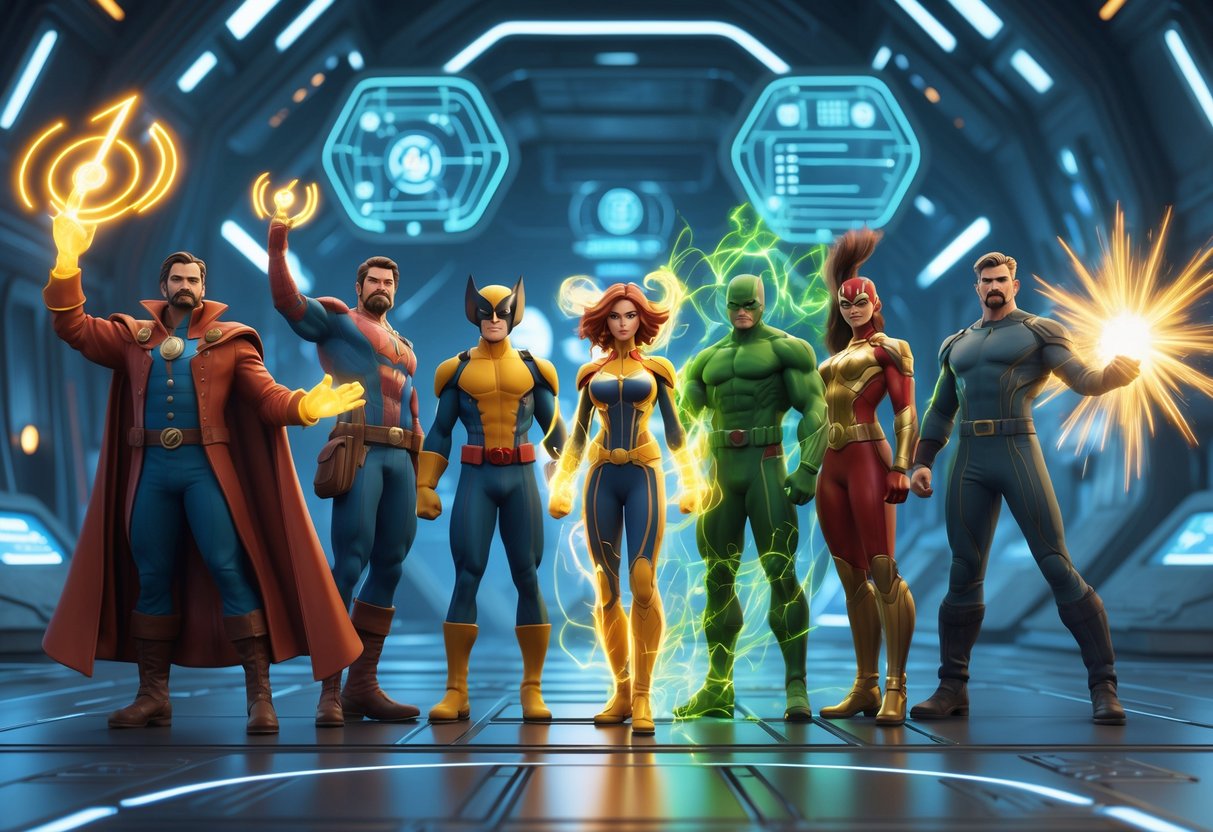
Good healing and sustain are what keep your team in the fight, especially when things get messy. If you mix in the right support heroes and play for sustain, your comp can feel nearly unkillable.
Healers and Support Characters
Mantis really stands out as one of the most dependable healers in Marvel Rivals. She heals steadily with her beam and can knock out enemies with her sleep dart.
Her kit feels simple and just works in most team setups.
Luna Snow brings big area healing when she pops her ultimate. Her frost attacks slow enemies and boost healing for the whole team.
Pairing her with Adam Warlock? That’s a classic for max healing.
Adam Warlock can resurrect teammates and heal, which turns the tide in close games. Teams usually run him with another healer for even more sustain.
Jeff the Land Shark keeps things interesting with mobile healing. He can swallow teammates to get them out of danger and move them to safety, which is pretty unique.
Invisible Woman gives shields instead of direct heals. Her barriers block damage and carve out safe spots for her team.
She’s best when paired with a regular healer, making protection even stronger.
Sustain Strategies
The triple Strategist composition lets teams cycle healing ultimates for over 40 seconds straight. Teams have to coordinate, though, or they’ll waste their ultimates all at once.
Groot and The Thing keep themselves up through sheer toughness. Their big health pools and damage absorption buy time for healers to work.
Anti-healing counters like Blade can really mess with teams that stack healers. If you see these picks, it’s smart to switch to shield-based protection.
Keep your healers tucked behind cover and close to escape paths. They’re always high-priority targets, so staying alive means your team lasts longer in fights.
Map and Mode-Specific Compositions
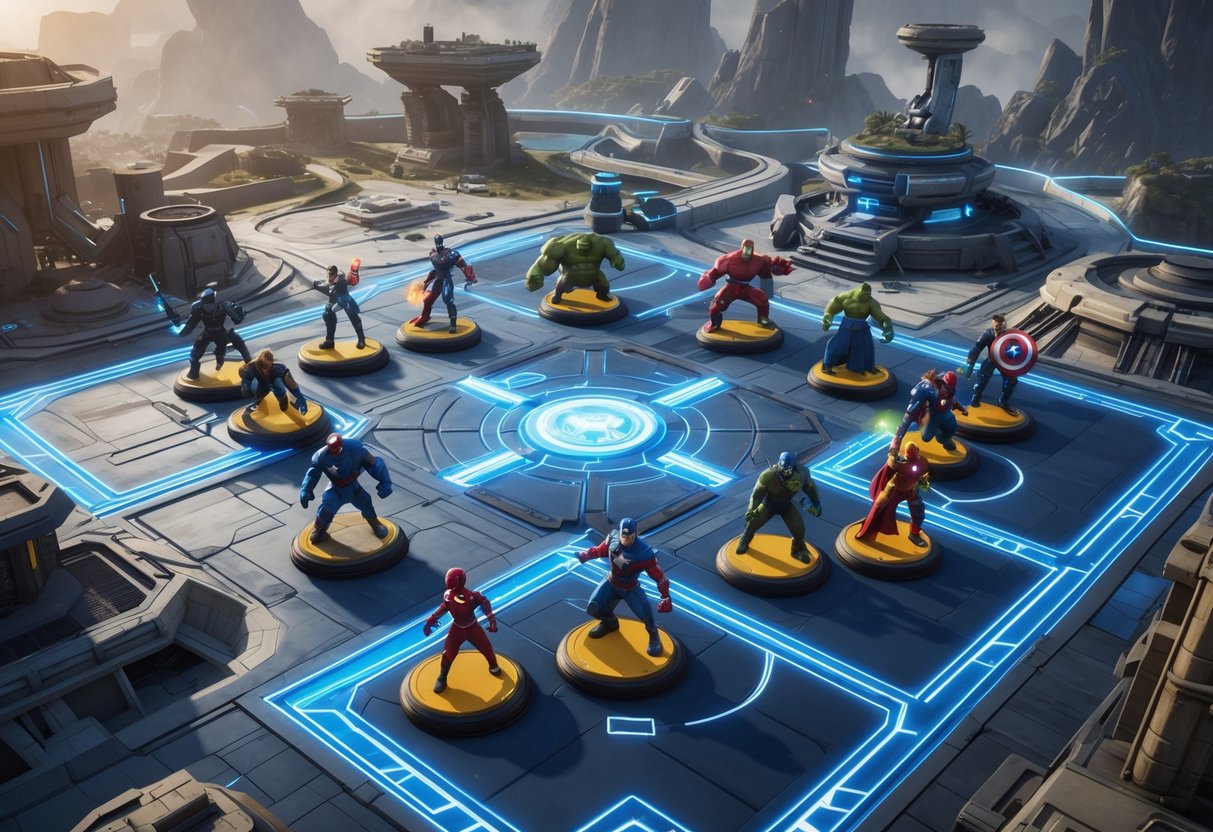
Marvel Rivals maps and game modes definitely need different team compositions if you want to win. Tight, enclosed maps favor close-range heroes and area control, while payload and control modes need strategies focused on objectives.
Compositions for Tight Maps
Tight maps with cramped corridors and small rooms change everything about team comps. Here, heroes who dominate close-range fights and control space shine.
Tank Selection for Confined Spaces:
- Hulk smashes through tight areas with his gamma powers.
- The Thing locks down narrow passages with crowd control.
- Groot can block whole corridors with his walls.
DPS Heroes That Shine:
Close-range damage dealers just thrive here. Wolverine becomes a menace in tight quarters, thanks to his healing and leaps.
Spider-Man uses walls and ceilings for sneaky attacks.
Phoenix and Scarlet Witch bring area damage that’s much harder to dodge in small rooms. They can clear out groups fast.
Strategic Positioning:
Stick your Strategists (healers) behind cover or tanks. Luna Snow and Mantis heal through walls, so they’re solid picks.
Team-Up Synergies:
Try running Wolverine with Phoenix for the Primal Flame team-up. In tight spaces, that combo is brutal since enemies can’t escape the burn.
Best Teams for Payload and Control Modes
Payload and control modes call for different tactics than plain deathmatch. Teams need to control the map and win long team fights.
Payload Attack Compositions:
When you’re pushing the payload, you want steady healing and protection around the cart. It’s usually best to run two Strategists—Luna Snow and Mantis make a strong pair.
Namor clears defenders off the payload with area denial. Pair him with Hulk and use the Gamma Charge team-up for a big push.
Defensive Control Setups:
- Peni Parker locks down choke points with her spider nests.
- Rocket Raccoon blocks areas and helps the team.
- Magneto moves enemies away from objectives.
Essential Team Structure:
| Role | Primary Pick | Secondary Pick | Purpose |
|---|---|---|---|
| Tank | Hulk/Namor | The Thing | Objective presence |
| DPS | Phoenix | Wolverine | Area control |
| Strategist | Luna Snow | Mantis | Sustained healing |
Convoy Mode Strategy:
Convoy matches need teams that can move fast. Bring at least one mobile DPS like Spider-Man or Wolverine to rotate between objectives.
Storm and Jeff the Land Shark pair up for the Jeff-Nado team-up, which keeps control points locked down.
Timing Your Team Swaps:
Don’t forget you can swap heroes mid-match. Go defensive when holding objectives, then switch to aggressive picks if you need to retake control.
Hero Highlights for Top Team Builds
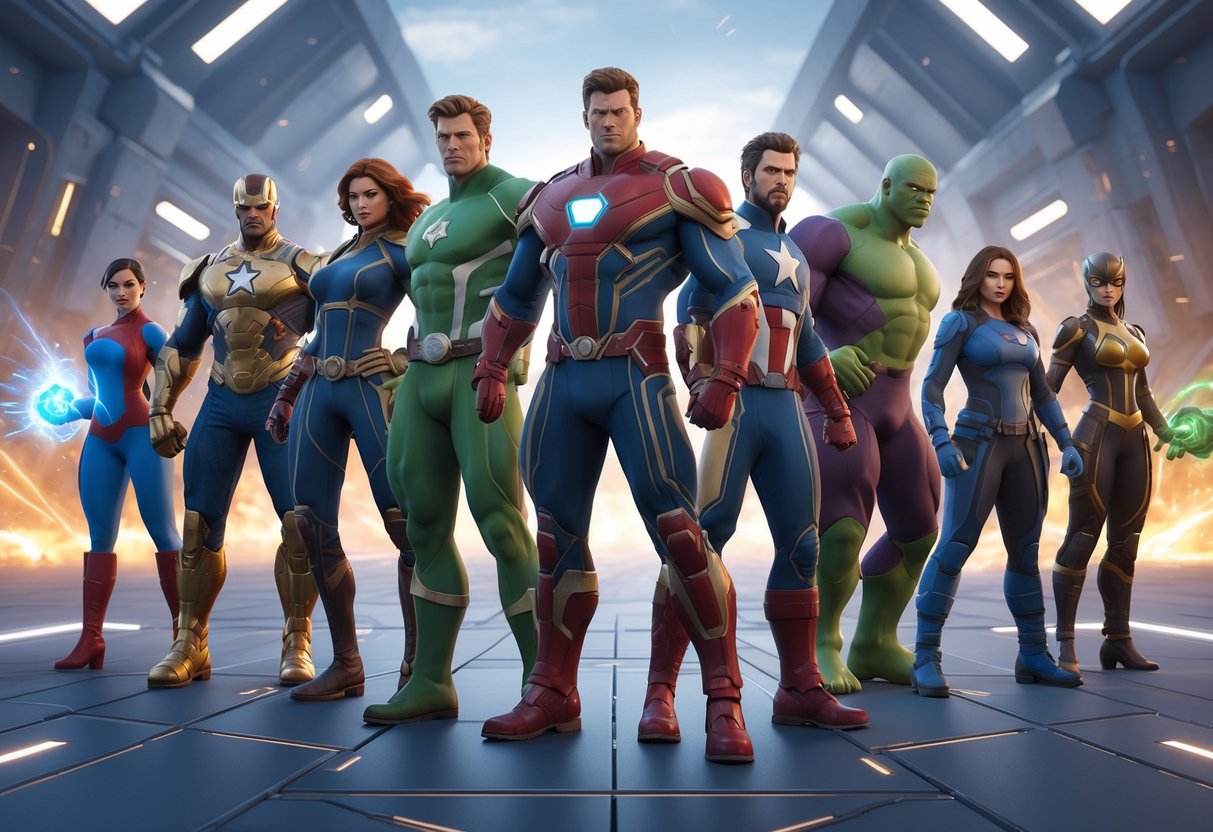
The best team comps in Marvel Rivals rely on smart hero combos. Team-Up abilities and skill synergies can swing matches fast—sometimes it feels unfair.
Hero Spotlight: Captain America and Winter Soldier
Captain America anchors defensive teams with his shield. He brings crowd control and damage reduction for everyone.
Cap’s Shield Throw bounces between enemies, so he’s great against grouped foes. His defensive stance soaks up tons of damage and keeps teammates safe.
Winter Soldier dominates mid-range duels with his cybernetic arm. He can hook enemies out of position, setting up easy eliminations.
Together, these two control the battlefield. Winter Soldier gets more ammo and damage when Cap’s buffs are active.
They work best in:
- Brawl comps where fights are up close
- Area control on Domination maps
- Anti-dive setups to stop mobile enemies
They do struggle against teams that poke from far away, though.
Hero Spotlight: Groot and Rocket
Groot plays both vanguard and strategist. His Flower Wall gives cover and healing, making him perfect for area control comps.
His Nature’s Wrath ultimate lays down huge damage zones and forces enemies to move. Groot’s walls block sight and heal allies.
Rocket supports the team with his C.Y.A. damage boost and healing orbs. His Rez Beacon brings teammates back instantly in clutch moments.
The Peni-Rocket Team-Up lets you place more nests and mines. This duo dominates chokepoints and objectives.
Key synergies:
- More healing by stacking their abilities
- Strong objective control on Domination maps
- Good counter-pressure against dive teams
- Great ultimate cycling
They’re best in area control and triple-strategist comps with endless healing.
Hero Spotlight: Storm and Squirrel Girl
Storm brings steady area damage and team buffs with her weather powers. She boosts multiple allies at once if you position her right.
Her flight helps her get great positions or escape. Storm’s ultimate covers big zones and clears out objectives.
Squirrel Girl disrupts team fights with her crowd control and mobility. She gets into enemy backlines and escapes easily.
Her kit interrupts enemy ultimates and causes chaos. She’s especially good against grouped teams.
Combined advantages:
- Superior aerial control in flying comps
- Excellent harassment of enemy healers and DPS
- Strong team fight starts with area control
- Flexible positioning for any map
This pair shines in flier and hybrid team comps that mix up the usual roles.
Combining Ultimate Abilities for Maximum Impact
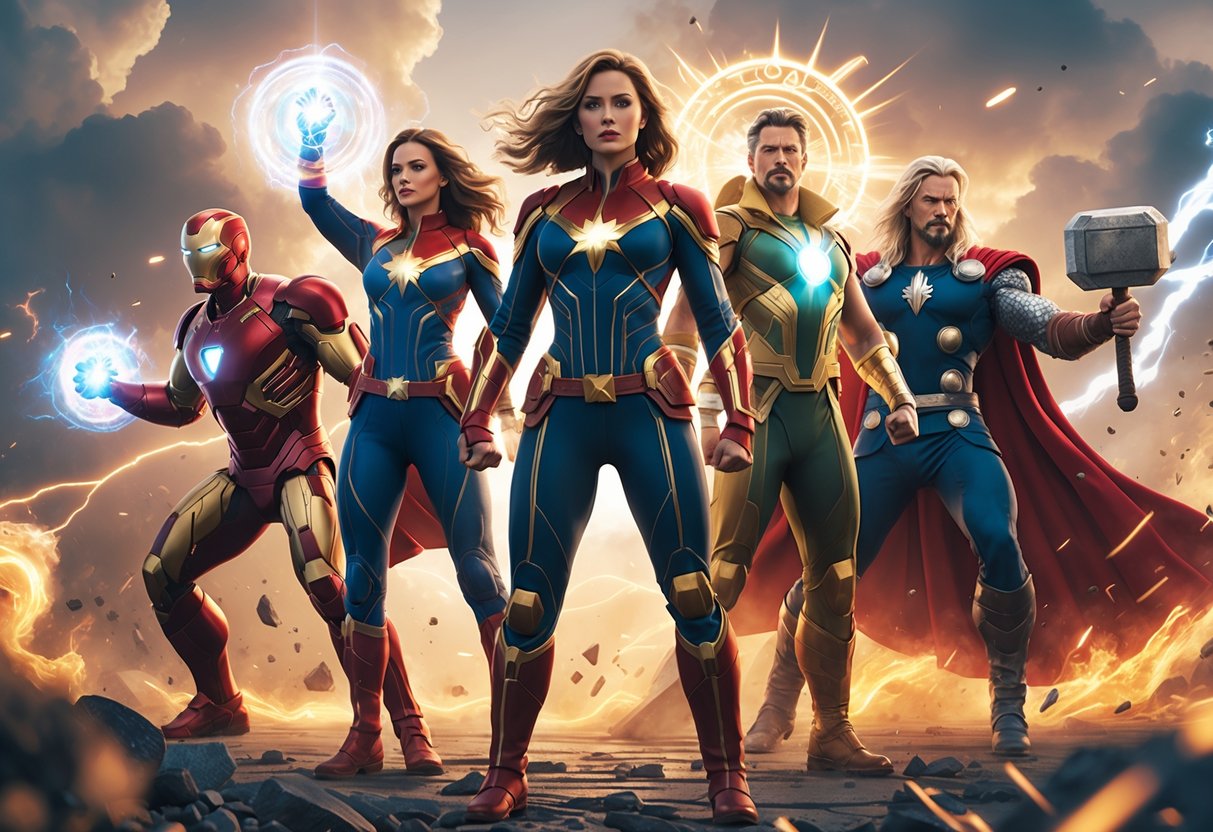
When teams nail their ultimate combos, Marvel Rivals matches can flip in an instant. The best squads chain crowd control like Magneto’s Metal Bulwark with huge damage from Scarlet Witch for game-changing plays.
Ultimate Combos in Meta Teams
Meta teams pick heroes whose ultimates work together for instant team fight wins. Magneto and Scarlet Witch are still one of the top combos.
Magneto’s Metal Bulwark gives Scarlet Witch crowd control immunity while she channels her ultimate. That means she can dump all her damage without getting interrupted.
Emma Frost’s Mental Projection sets up area ultimates. She tanks damage in diamond form and uses psychic powers to group enemies for follow-ups.
You have to time these combos just right. Here’s a quick chart for reference:
| Hero Pairing | Setup Ultimate | Follow-up Ultimate | Key Timing |
|---|---|---|---|
| Magneto + Scarlet Witch | Metal Bulwark | Reality Erasure | Immediate overlap |
| Emma Frost + Psylocke | Mental Projection | Dance of Butterfly | 2-second delay |
| Doctor Strange + Iron Man | Eye of Agamotto | Invincible Pulse Cannon | Stun activation |
Team-up abilities add another twist. If heroes share a team-up connection and stand close, their abilities get a supercharged version.
Best AoE Synergies
Area-of-effect combos are king for controlling points and wiping groups. Psylocke’s Dance of the Butterfly is especially strong when crowd control pins enemies in place.
The best AoE setups combine displacement and burst damage. Jeff the Land Shark’s ultimate pulls enemies together, making them easy targets for your damage dealers.
Groot’s Strangling Prison roots enemies long enough for teammates to stack ultimates on top. It’s one of the best AoE setups in the game.
Some AoE combos we’ve seen win fights over and over:
- Rocket Raccoon’s damage amp (40% boost) with Punisher’s Final Judgement
- Winter Soldier’s multi-dash plus Cloak & Dagger’s Terror Cape debuff
- Luna Snow’s crowd control into Mantis’s boosted Life Orbs
The trick is communication and positioning. Find chokepoints or objectives where enemies bunch up, then drop your ultimates for max impact.
Underrated and Niche Team Compositions
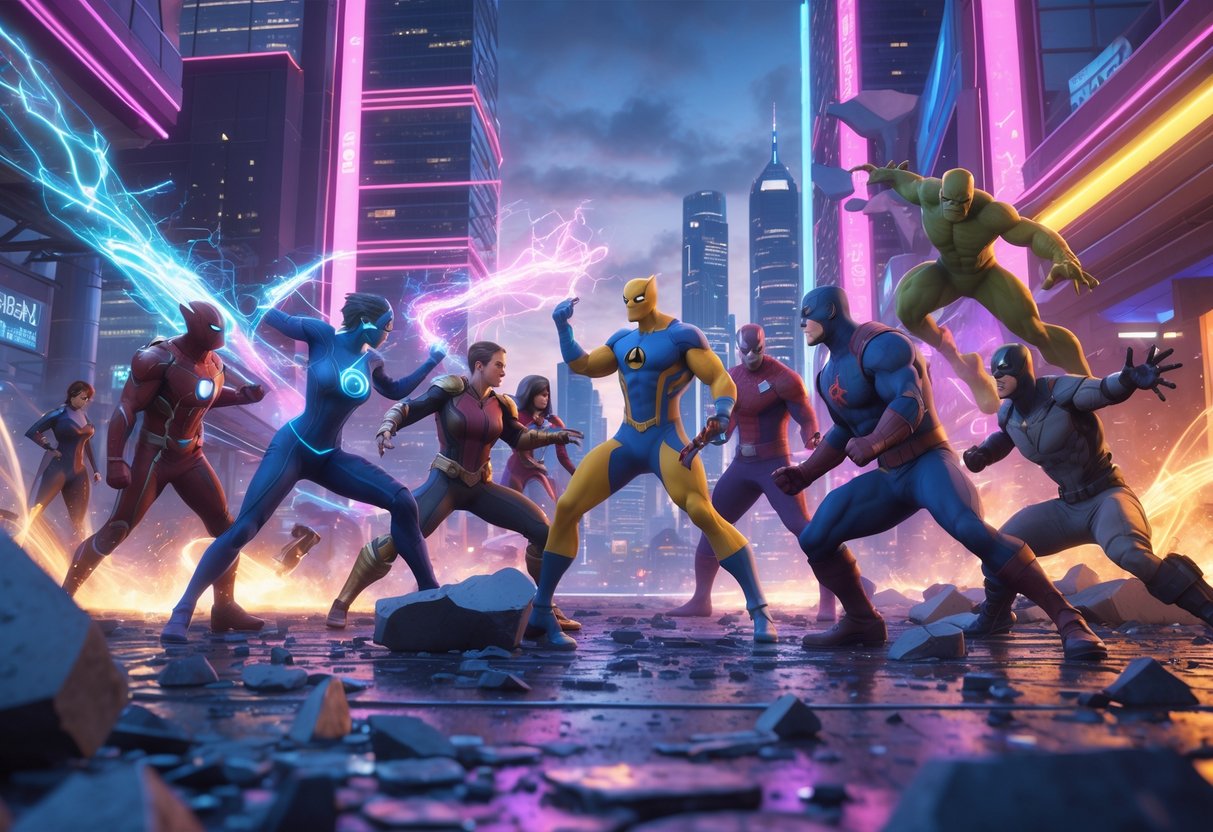
Some team comps fly under the radar but can be absolute nightmares for the enemy. These builds focus on disruption and pure chaos.
Chaos Creation Team
This comp is all about confusion and disruption, not just raw damage.
Core Heroes:
- Groot (Vanguard)
- Jeff the Land Shark (Strategist)
- Psylocke (Duelist)
Groot blocks sightlines and drops walls where enemies least expect. His wall placement forces awkward fights.
Jeff brings wild crowd control and can yank key targets out of the action. His devour move breaks up enemy formations better than any straight-up damage dealer.
Psylocke takes full advantage of the chaos. She teleports behind distracted enemies and secures eliminations.
Supporting Cast:
Throw in Loki for illusions and Mantis for steady healing. Storm works well as a sixth pick for area denial.
This comp falls apart against teams that communicate well. But if the enemy is disorganized? It’s a nightmare.
Walking Disaster Core
This setup builds around The Thing and Punisher for unstoppable pushes.
The Thing acts as an immovable wall, leading the charge through choke points. His defense lets the team push up safely.
Punisher follows up with huge close-range damage once The Thing cracks open space.
Team Structure:
- The Thing + Punisher (core duo)
- Venom (extra frontline)
- Adam Warlock + Luna Snow (healing support)
- Iron Fist (mobility and flanks)
This comp thrives on payload maps where you need to keep moving forward. The constant pressure wears defenders down.
Weakness: Teams with strong area denial can stall them out. High-mobility enemies who keep their distance can kite this comp all day.
Seasonal Meta Shifts and New Arrivals
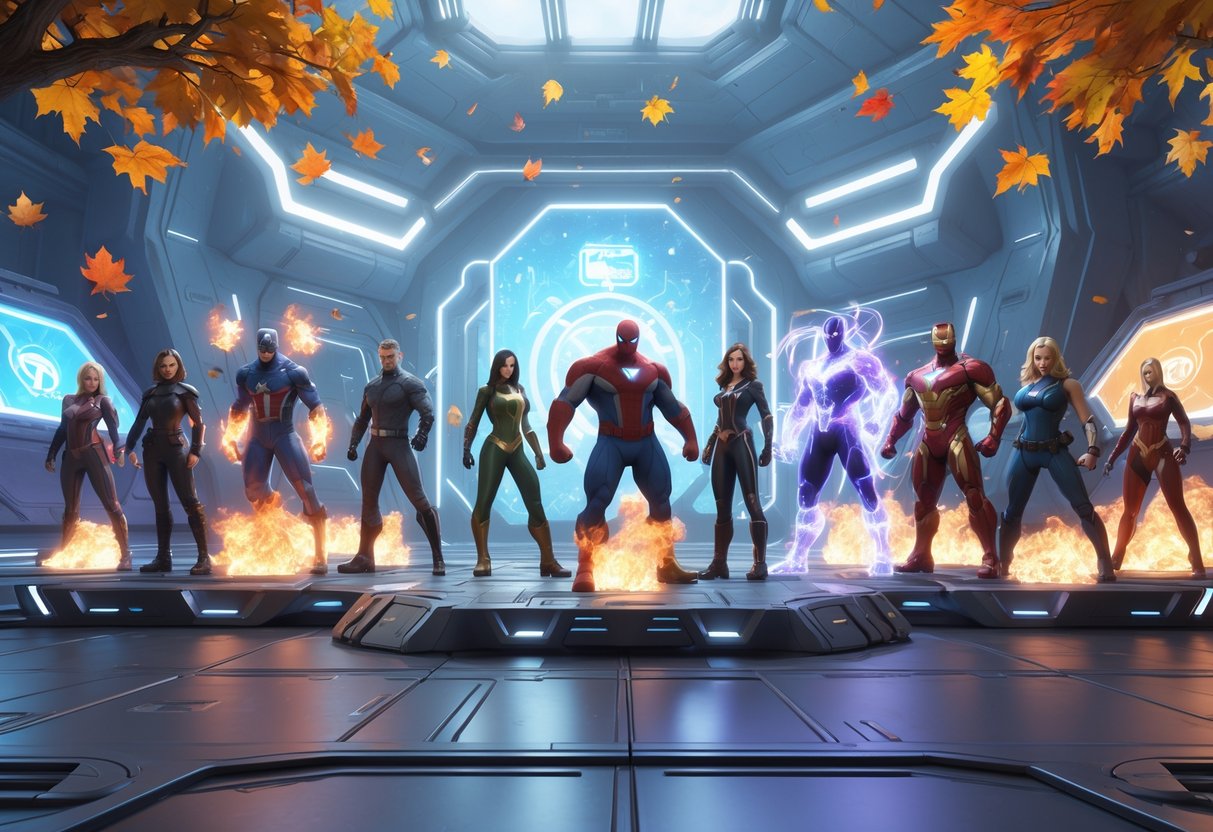
Season updates in Marvel Rivals always shake up team compositions. When new heroes like Blade join the roster, they totally change healing strategies. Fresh team-up abilities constantly lead to new gameplay approaches, so the game never really sits still.
Season 2 Updates
Season 2 brought in balance changes that really shook up competitive play. Team-up abilities suddenly became a core part of team building.
Flier-focused comps took off—Iron Man, Ultron, and Storm started dominating the skies. They basically owned vertical space for a while.
People responded fast with anti-flier counters. Teams with Hela, Punisher, and The Thing started hunting down flying heroes using hitscan weapons and crowd control.
Triple Strategist comps popped up too. Teams ran three support heroes, cycling defensive ultimates for almost constant healing.
The meta got more reactive. Instead of just running general comps, players started building lineups to counter specific threats.
Emerging Heroes and Abilities
Blade changed everything in Season 3 with his anti-healing skill. He’s still the only hero who can completely shut down enemy healing.
Everyone either grabs Blade first or builds a comp to deal with his anti-heal. He’s a pick-or-ban staple in competitive matches.
Luna Snow’s new team-up with Warlock brought some wild synergies. The Vibrant Vitality comp mixes their healing abilities for ridiculous sustain.
Three big immortal abilities really define high-level play now:
- Regen Domain for team-wide healing
- Soul Bond for keeping allies alive
- Duality Dance to block damage
Peni-Rocket team-ups got a boost in area control. Extra nests and resurrection beacons with mine spawning made holding objectives a lot easier.
All these new tools pushed teams into more specialized roles. We don’t see as many jack-of-all-trades comps anymore—everyone’s going for targeted strategies.
Tips for Building Your Own Best Team
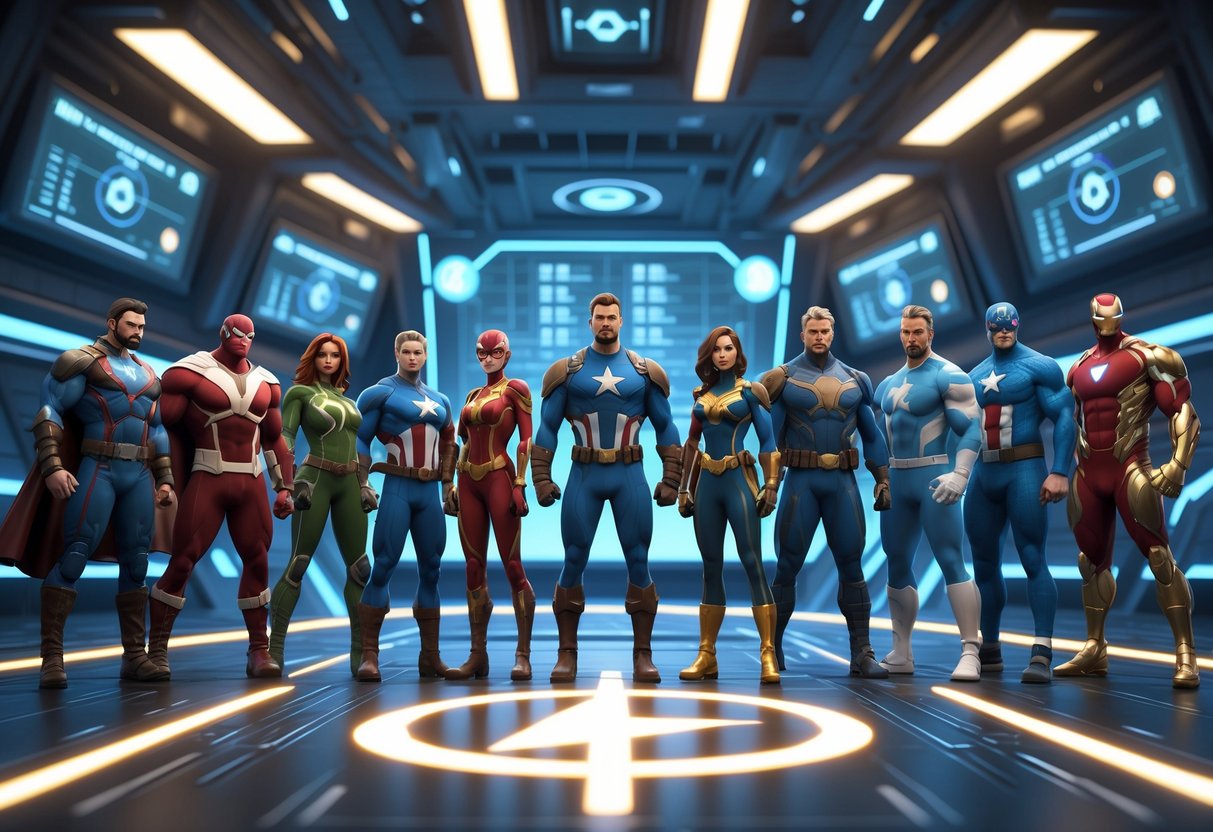
Building good team comps means adapting to what the enemy picks. The top players keep experimenting with hero synergies. Staying curious about new team-ups is half the fun, honestly.
Adapting To Opponents
Always check the enemy team selection screen. If they pick dive heroes like Spider-Man or Venom, we need to answer with heroes who can peel for teammates.
Emma Frost and Magneto work wonders against dive comps. Emma’s diamond form blocks damage, and her shields are great for protecting the team. Magneto’s barriers push back aggressive attackers and give us room to breathe.
If you’re facing snipers like Hawkeye or Hela, try mobile heroes. Storm flies around sightlines, while Jeff the Land Shark sneaks through odd routes to flank.
Tank-heavy enemy comps need a different approach:
- Pick Scarlet Witch for her burst damage
- Use Winter Soldier for sustained DPS
- Try Punisher after his Season 2.5 buffs
Against teams stacked with Strategists, burst damage is the way. The Doctor Strange and Scarlet Witch team-up can blow up key targets before healers react. Their Portal Bomb combo is especially nasty.
Experimenting With New Synergies
Marvel Rivals offers over a million team combos. We should mess around with different hero pairings—sometimes the weirdest ones work best.
Team-up abilities are where the real magic happens. Storm and Jeff’s “Jeffnado” is still popular, but there are plenty of underrated pairings that catch people off guard.
Try mixing up roles. Mister Fantastic can act as a pseudo-tank even though he’s a Duelist. His stretchy skills help him peel for others while still dealing damage.
Give these underused combos a shot:
- Groot and Rocket for defense
- Iron Man and Ultron for air control
- Hela and Loki for resurrection plays
Practice new comps in casual matches before jumping into ranked. Each pairing needs different positioning and timing, no way around it. The Fantastic Four synergy (Thing, Mister Fantastic, Invisible Woman) only works if you time your engages together.
Patch notes always shake things up. When Punisher got damage buffs in Season 2.5, he suddenly fit aggressive 1/3/2 comps. Keep an eye on updates to spot new synergies before everyone else does.
Frequently Asked Questions
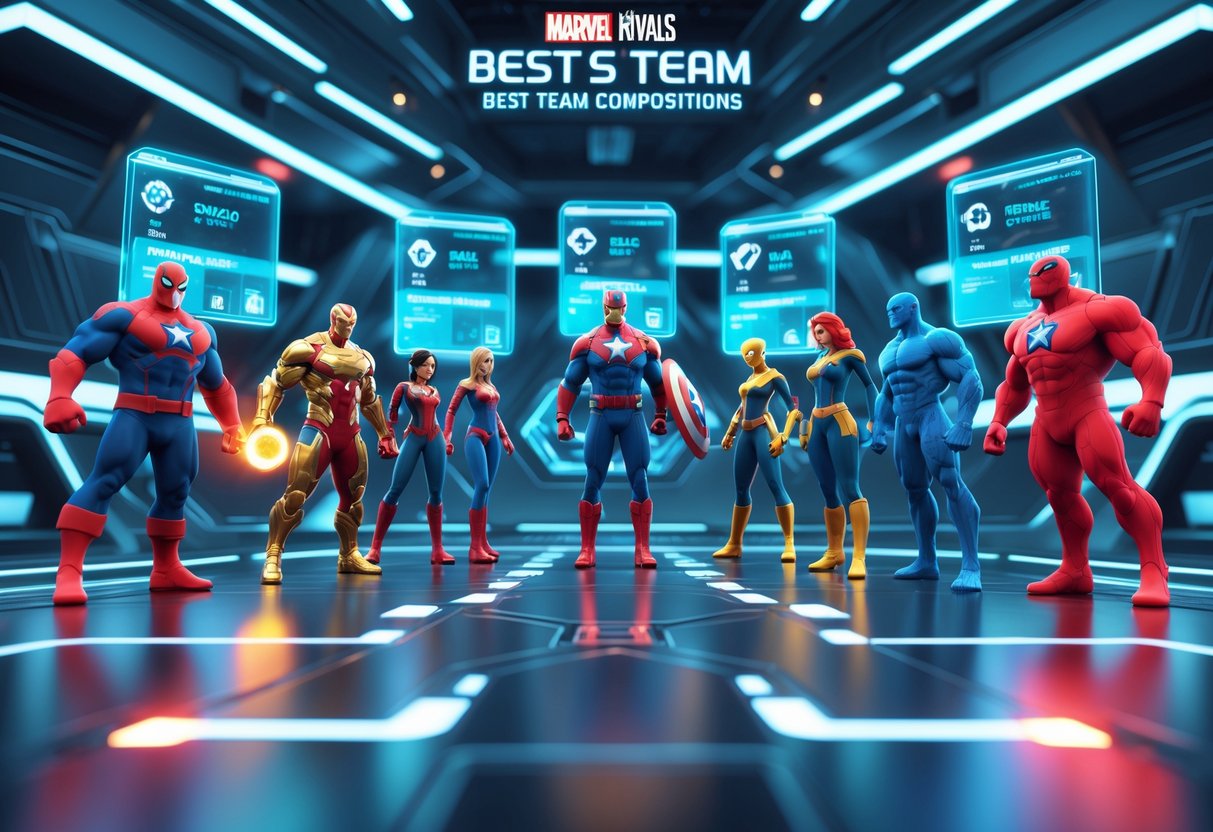
Here are some common questions about team synergies, beginner team comps, counter strategies, meta shifts, tournament tactics, and those oddball character combos that can catch opponents off guard.
What are the top team synergies currently dominating in Marvel Rivals?
Right now, Team-Up abilities are king. Heroes with complementary Team-Up skills just control the battlefield.
Quick win: Try duos like Spider-Man and Venom, or Iron Man and Hulk for instant synergy.
Doctor Strange pairs up well with portal-heavy heroes like Spider-Man. That combo opens up sneaky flanking routes and escape plays.
Tank-heavy duos like Hulk and Thor make a wall on control maps. Most teams just can’t break through them.
Support pairings like Mantis and Luna Snow offer crazy sustain. Their healing keeps pushes going way longer than single-healer setups.
Can you suggest some effective team compositions for beginners in Marvel Rivals?
If you’re new, start with a balanced 2-2-2 comp with two Strategists for healing. It’s forgiving if you make mistakes and still works well.
A solid beginner lineup: Hulk and Magneto as tanks, Spider-Man and Punisher for damage, Mantis and Luna Snow for healing. These heroes are easy to pick up and mesh well together.
Warning: Avoid complicated Team-Up combos at first—they need precise timing.
Iron Man, Captain America, and Rocket Raccoon also work great as a starter trio. Their kits fit together without needing perfect coordination.
Pick heroes with straightforward abilities. Punisher and Hulk both hit hard and don’t require tricky mechanics to use.
Which hero combinations should I focus on to counter popular team builds?
Dive comps can wreck long-range poke teams. Pair Spider-Man and Venom to close distance and disrupt backlines.
Anti-heal comps do well against double-support teams. Heroes like Wolverine can delete healers before they stabilize.
Quick win: Storm and Scarlet Witch together can zone out most tank-heavy comps with area denial.
Shield-breaking duos like Iron Man and Star-Lord can smash through barriers and force enemies to reposition.
Mobile flankers like Black Panther, paired with a distracting tank, split enemy focus. It’s tough to defend when threats come from all sides.
What’s the latest meta for team formations in Marvel Rivals following the recent update?
Hybrid comps are everywhere. Teams now mix heroes who can flex into different roles, making strategies less predictable.
Double-tank comps with high-damage supports are on the rise. You get durability and enough damage to win fights.
Recent changes reward heroes with mobility and escape tools over static play.
Team-Up synergies matter more than individual hero strength. Coordinated abilities usually beat raw numbers in close matches.
Flexible positioning works better than fixed setups. Teams that switch between offense and defense on the fly adapt faster to map changes.
How can I adapt my team strategy to effectively compete in Marvel Rivals tournaments?
Tournament play needs a deep hero pool and several comp options. Prep at least three team setups for different maps and opponents.
Scout opponents when you can. Most teams have favorite comps and habits that you can exploit.
Warning: Don’t reveal your best comps early if bracket resets are possible.
Practice fast hero swaps between rounds. Tourney formats usually let you change comps, which can totally flip a match.
Communication is everything in tournaments. Set clear callouts and roles before the match so no one gets lost in the chaos.
What are some underdog characters that pair well together for unexpected victories?
Jeff the Shark teams up with Rocket Raccoon, and honestly, they can pull off some wild harassment combos. Their speed and knack for causing chaos often leave teams scrambling, totally unprepared for the nonstop pressure.
Namor and Storm? People rarely expect their area control to be this strong. They can lock down whole sections of the map, and it catches opponents off guard more often than you’d think.
Winter Soldier with Cloak & Dagger can surprise everyone with their burst potential. They just delete high-priority targets before anyone even knows what’s happening.
Magik joins forces with Psylocke, and suddenly you’ve got portal-based flanks that ignore most defensive setups. Most teams never even think to counter these kinds of mobility tricks.
Quick win: Try out these offbeat duos in casual games first. Once you get the hang of them, then bring them into competitive play.

